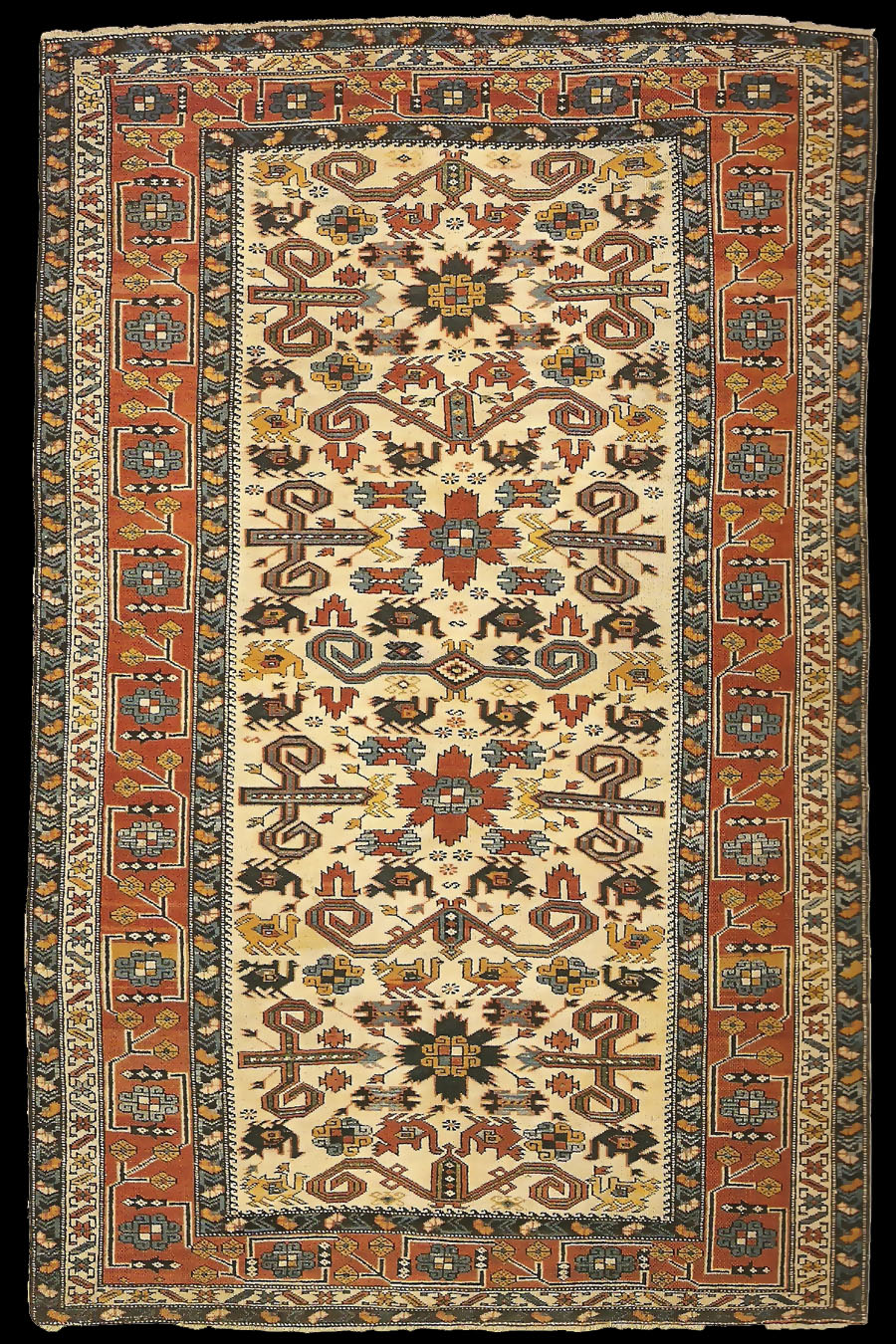 |
29 Kuba Perepedil Rug
(published at Alberto Boralevi "Splendori di Citta, Tesori Di
Villaggio, Antichi Tappeti Dalla Persia E Dal Caucaso", La Torre, Tappeti
Orientali)
Northeastern Caucasus
(Azerbaijan)
Early 20th century
Wool pile on wool
foundation, 198 x 124 cm
One of the best known
Caucasian rugs, even in Italy, is the Perepdil (also Prepedil or Pirbedil)
that distinguishes a pattern characterized by a ram's horn motif repeated on
the field, generally on a blue background, even though there are some rare
variants in red or white such as the one shown here. The horn motif appears
in two versions: a horizontal one aligned on the central axis and a vertical
one on the sides, with a sort of sword or dart that emerges from the middle
of the horn. On the central axis, alternating with the horn there are ragged
palmettes around which there are four curious ornaments that seem to be
stylized birds. A careful study of the origins of this design that is based
on textile models, especially 17th and 18th century Azerbaijani silk
embroideries, are in turn, related to the style of the antique "dragon
carpets", has made it possible to ascertain that they are not birds at all,
but originally floral motifs that have been stylized into bird shapes. There
has also been much speculation about the horn motifs, and even if they can
be readily traced to the archaic Turkish and Turkmen traditions according to
which the ram's horn had a protective function and because of this was used
to decorate the entrance to the tents, some have interpreted the "horn and
dart" as a clear phallic symbol, and the horizontal horn as a depiction of
the female genital organs. Even though the pattern is already rich in
ornaments, these rugs never lack "filler motifs" that take up any available
space on the field. Not everyone knows that there is also a second Perepedil
pattern that consists of a variation of the Persian herati motif. It is
usually on a blue background with a palmette border on red. A variation of
that border with stylized rosettes in place of the palmettes enclosed by a
meander of orthogonal vines is what we see in our rug here .and it is quite
unusual for a Perepedil. The smaller frames, however, are much more classic
with a typical pattern of carnations on a black ground and stars in a
meander of stylized leaves on a white ground. |
|
29
Kuba Perepedil
Caucaso Nord Orientate, Inizio XX secolo
Vello
in lana su armatura in lana 198 x 124 cm.
Tra i
nomi dei tappeti caucasici, uno dei piu conosciuti anche da noi in Italia e
quello di Perepedil (detto anche Prepedil o Pirbedil),
che contraddistingue un pattern caratterizzato da un motivo a corna d'ariete
ripetuto sul campo, generalmente a fondo blu, anche se esistono piu rare
vaiianti in rosso o in bianco, come l'esemplare qui illustrato.
II
motivo a corna appare in due versioni: una orizzontale, allineata sull'asse
centrale, ed una verticale ai lati, con una sorta di spada o di dardo che
fuoriesce al centra delle corna. Sull'asse centrale, alternati alle corna,
sono poi collocati dei motivi a palmetta frastagliata, attorno ai quali sono
disposti quattro curiosi ornamenli, che sembrano uccelli stilizzati. Un
attento studio delle origini di questo disegno, che deriva da modelli
tessili, soprattutto ricami azerbaijani in seta del XVII e XVIII secolo, a
loro volta connessi allo stile degli antichi 'tappeti a 'draghi', ha pero
consentito di accertare che non si tratta di veri uccelli, ma di motivi
originariamente floreali, stilizzati in forma di uccello.
Anche
sui motivi a corna si e molto speculato e, sebbene questi siano facilmente
riconducibili alle arcaiche tradizioni turche e turcomanne, secondo le quali
le corna di ariete avevano un valore protettivo e venivano per questo poste
a decorare 1'ingresso delle tende, c'e chi ha
voluto vedere nel motivo di 'corna e dardo' un chiaro simbolo fallico e
nelle corna disposte orizzontalmente, addirittura una raffigurazione
dell'apparato genitale femminile. Sebbene il disegno nel suo complesso sia
gia denso d'ornamenti, non mancano mai anche in questi tappeti 'motivi di
riempimento', che vanno ad occupare qualsiasi spazio disponibile sul campo.
Non tutti sanno che esiste anche un secondo disegno tra i Perepedil, che
consiste in una variante del motivo persiano herati, solitamente a fondo blu,
accompagnato da una bordura a palmette su fondo rosso. Una variante di
quella bordura, con delle rosette stilizzate al posto delle palmette,
racchiuse da un mcandro di tralci ad andamento ortogonale, e quella che
vediamo nel nostro esemplare, piuttosto insolita per un Perepedil. Molto piu
classiche sono invece le cornici minori, con un tipico motivo a garofani su
fondo nero, e a stelle entro un meandro |

